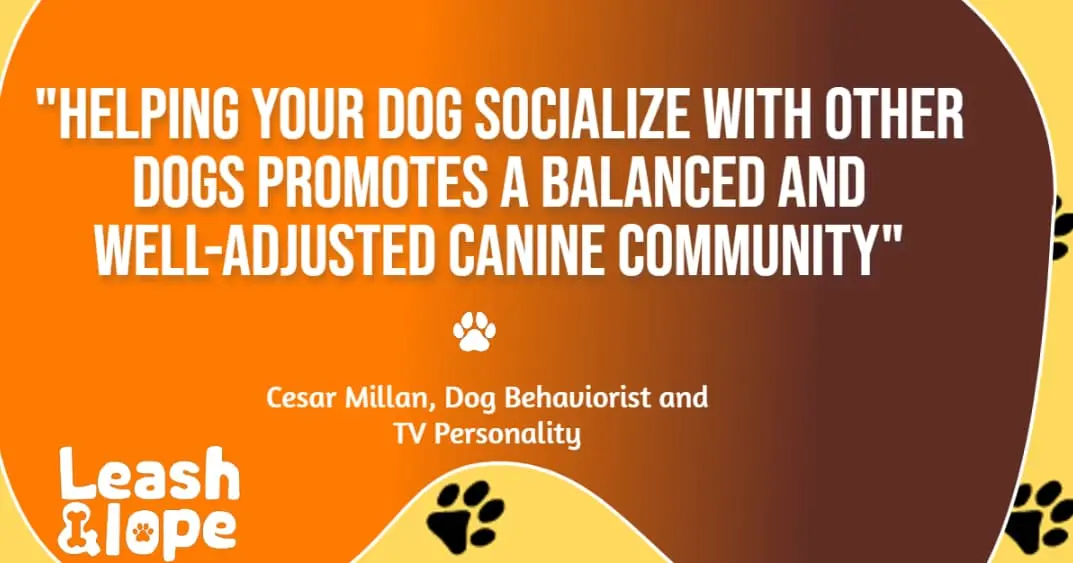Is your furry friend displaying signs of aggression, fear, or/and shyness? Is the situation still the same despite the efforts you’ve put into the training of your dog? well, socializing your dog with other dogs can overcome these challenges and discover effective techniques and essential tips to introduce your furry friend to fellow canines.
The process should be followed step-by-step. The end result is very rewarding because the happy paws of your furry pal will make your life paw-feet and cheerful. This article will help you raise your dog, leading to long-lasting friendships and teaching them with other dogs as well as with humans.
Starting the Socializing Training in Puppyhood

Starting socialization training during puppyhood is like introducing your furry friend to the world in a fun and positive way. It’s kind of like taking your puppy on playdates with other dogs and people. This helps your puppy become more friendly, confident, and happy.
See How to stop a puppy from biting the leash.
You can take your puppy to different places, like parks or even around your neighborhood. So, they can experience new things like new sounds and sights. Also, it’s a good idea to let them meet and play with other dogs.
Before you start this training, it’s quite important to have the basic knowledge. This is because, insufficient and poorly supervised training can lead to some harmful consequences in adulthood, such as:
- Poor communication between the dog and the owner
- Less public interaction
- Constant fear
- Low confidence
- Low energy
- Destructive behavior like aggression
- Poorly developed intellective skills
Three Phases of Puppy Development: Primary, Socialization, and Improvement

You might be familiar with the idea of personal growth and development. Just like humans, puppies also go through various stages of development that shape their behavior and personalities.
The puppies go through three phases before they finally step into adulthood–the primary phase, the socialization phase, and the improvement phase.
Primary phase
- The primary phase usually lasts from birth to 3 weeks.
- In this phase, puppies usually rely on their mother and their sense of touch is the most active.
- Research shows that puppies handled with gentle care during this phase of their lives respond more calmly later in life. This, in turn, helps in the socialization process.
Socialization phase
- The socialization phase starts in the fourth week and lasts approximately 14 weeks.
- This is a very critical phase for the development of the puppies as they are highly influenced by their surrounding environment. Hence, any traumatic events should be avoided because they can manifest as negative social patterns in adulthood.
- It is the best period of a puppy’s life for the development of a long-lasting relationship with humans. Therefore, if your puppy is around this age then make sure that your relationship with your puppy is progressing pleasantly. Any fear developed can quickly vanish provided the interaction is handled gently. Research shows that if puppies have been subjected to little to no human exposure during this period. They aren’t able to let go of their fear permanently. Hence, it leads to increased fear of unfamiliar environments, which further leads to the development of ill behavioral patterns.
- You should have a “puppy and me” time quite often during this phase. It can help strengthen the bond between your puppy and you. Puppies love it when you rub their bellies. They also love soothing strokes on their back. Establishing warm eye contact, playing games with them, and rewarding them with treats can help develop a bond of trust between you both as well. When it’s combined with obedience training, it becomes a solid base for a well-organized socialization process.
- Puppies who aren’t subjected to interaction with other animals of any species, also exhibit ill behavioral patterns later in their life.
- Engaging in well-organized and properly supervised play sessions with other well-trained dogs during this phase of a puppy’s life can reinforce positive emotions and understanding of body language.
- Make sure that your puppy is vaccinated.
- Expose your puppy to new sounds gradually.
Improvement phase
- This phase usually starts after the socialization period ends and lasts till approximately 12 months.
- The socialization process doesn’t end in the socialization phase of puppyhood. Rather, it continues for the rest of the puppy’s life.
- Hence, exposure to humans, animals, new environments, and objects can exhibit a positive behavioral response IF the puppies have been given proper training during their socialization period.
Now. that we have the basic knowledge, let’s proceed forward.
Obedience training
Before you take your dog to socialize with other dogs, make sure that your dog is obedient to your commands. This can help in preventing some uncomfortable situations that can arise during the interaction.
Choose the Dog with Whom you Want Your Dog to Interact With
It’s something that some people neglect. Sometimes, the other dog may not be suitable for interaction with your dog. Hence, it can lead to negative social interaction. You should ensure that the other dog is vaccinated as well and that it is comfortable interacting with new dogs, otherwise, it can affect the health and behavioral pattern of your dog, respectively.
Start the Socialization Process by Interaction with One Dog
To begin socializing your dog, start by introducing them to just one other dog at a time. Think of it like setting up a playdate for your puppy. This way, your dog can get used to being around other dogs in a more controlled and relaxed environment. It’s like making a new friend for your furry pal, and it helps them become more comfortable and confident around other canines.
Take it slow, let them interact, and observe how they respond to each other. As they become familiar with one dog, you can gradually introduce them to more furry friends. Remember, it’s all about building positive experiences and friendships for your dog!
It’s quite helpful if you initiate the socialization process of your dog by making it interact with one dog at first. This is because, if you choose to go to a dog park, your dog can get anxious especially if your dog wasn’t trained efficiently in its puppyhood. Consequently, it can lead to discomfort.
Choose a Neutral Place to Socialize Your Dog with Other Dogs
When your dog meets with another dog, make sure it happens at a neutral place because:
- It enables both dogs not to get overwhelmed and calmly interact with one another.
- A neutral place is new to both of the dogs, therefore, they are less likely to feel possessive. This is because dogs can show defensive behavior when they get to interact with a new dog at their familiar places.
On-leash Interaction to Socialize Your Dog with Other Dogs
Off-leash interactions are beneficial for puppies but in the case of adult dogs, don’t start with an off-leash introduction. The reason is that adult dogs can, at times, see the other dog as an intruder and hence both dogs can harm each other and create chaos.
See if you feed your dog before or after an exercise.
So what should be done in this case? You should keep the dogs on leash and allow them to walk with each other but not close enough to touch. Walk them like this for some time so that both can become familiar with the smell of each other. In this way, they won’t perceive each other as a threat.
After that, you should allow the dogs to finally come closer to each other. Keep the interaction short.
Understanding the Body Language of the Dogs
Understanding the body language of the dogs while interacting can help a great deal to progressively enhance the socialization process.
The following signs show that the interaction between the dogs is going well:
- Wagging tails indicate that dogs don’t perceive each other as intruders and hence, they’re friendly with one another.
- They’re calm around each other. They don’t show any fearful or aggressive behavior.
- Their muscles aren’t stiff, there’s no tension and they portray relaxed body postures.
- They don’t stare at each other. They look at each other softly and warmly.
- They are friendly with each other. They sniff each other which shows that trust is developing.
If the engagement between the dogs isn’t going well, they can show the following signs:
- They give each other whale eyes (the whites in their eyes are visible).
- Their posture is stiff.
- Raised hackles can indicate arousal.
- Avoidant behavior can indicate discomfort.
- Growling can indicate aggression.
- Frozen tails and pricked-back ears can indicate submission, anxiety, arousal, and even observation.
Interaction with Multiple Dogs
Now that you’ve introduced your dog to another one, you can go ahead and introduce your dog to multiple dogs but under supervision.
You can initiate with on-leash interaction first and after a while, you can opt for off-leash interaction after carefully analyzing the situation.
The process of socialization of your dog continues till its last breath. The more exposure you give to your dog, the more it’ll be able to adapt to different environments.
Professional Help
At times, this whole socializing process can feel a bit exhausting and unmanageable. This is because a person with no more profound understanding of this stuff, can’t always understand the dog’s needs reliably.
In this case, you can also take professional help. A professional trainer can help in correcting unwanted behavioral patterns that can arise during this socializing process. Since they have an in-depth understanding of a dog’s behavior, they can help tremendously when it comes to the training of your dog. As a result, the overall socialization process, which is based mainly on the training of your dog, can be enhanced greatly and significantly.
Conclusion: Socialize Your Dog with Other Dogs
Many people get a dog as a pet but they usually neglect its mental and social health, though they take good care of their physical health. It can lead to some uncomfortable experiences. If you don’t care to socialize your dog with other dogs, it can definitely lead to aggressive behavior because of the development of mistrust and fear towards humans and other dogs.
In contrast, a thoroughly and flawlessly trained dog isn’t just a joy to be around, rather its presence is also soothing and radiant for its owner.
Certainly, the process of training and socializing is not as easy as it seems but the outcome of the relevant properly followed plan is worth it as it proceeds to add wholesomeness to your life by making the mental, social, and physical health of your dog–a complete marvel.

Dr. Haider is a general doctor with a unique level of connection to our four-legged friends. He is a valued contributor to our Website (Leash and Lope). Dedicated to providing accurate to dog owners in understanding and caring for their lovely pets.

